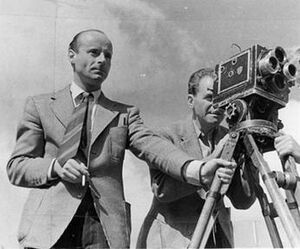Erwin Hillier facts for kids
Quick facts for kids
Erwin Hillier
|
|
|---|---|
 |
|
| Born | 2 September 1911 |
| Died | 10 January 2005 (aged 93) |
| Occupation | Cinematographer |
| Years active | 1931–1970 |
| Spouse(s) | Helen Yates-Southgate |
Erwin Hillier was a talented cinematographer (someone who plans and shoots movies) born in Germany. He became famous for his work in British films from the 1940s to the 1960s. He was born on September 2, 1911, and passed away on January 10, 2005, at the age of 93.
Starting a Film Career
Erwin Hillier was born in Germany. In the late 1920s, he studied art in Berlin. A famous director named F. W. Murnau was impressed by Hillier's paintings. Murnau offered him a job as a camera assistant for his film Tabu (1931).
Later, Murnau recommended Hillier to director Fritz Lang at UFA studios. Hillier then worked on Lang's classic movie M (1931). Soon after, Erwin Hillier moved to Britain to continue his film career.
In Britain, he started as a camera assistant for Gaumont Pictures. There, he worked with the famous director Alfred Hitchcock. He then moved to Elstree Studios. He worked on The Man Behind the Mask (1936) with director Michael Powell. Powell noticed Hillier's "insane enthusiasm" for his work. Hillier became a full cinematographer for the first time with the film Lady from Lisbon (1942).
Working with The Archers
Erwin Hillier's work on The Silver Fleet (1943) impressed Powell & Pressburger. This filmmaking team, also known as 'The Archers', hired Hillier. He became the cinematographer for their film A Canterbury Tale (1944). Michael Powell later said Hillier "did a marvellous job" on the movie.
Even though Powell had recently used Technicolor film, World War II meant they had to use black-and-white film. This was good because Hillier was very skilled with black-and-white. The film combined British realism with a German style called German Expressionism. This style uses strong contrasts of light and shadow, which Hillier had learned. The movie is well-known for how it showed the English countryside. Powell remembered how Hillier loved clouds and would sometimes wait for a cloud to appear before filming.
His next film was I Know Where I'm Going! (1945), again with The Archers. This movie continued the style of their previous work. It showed Hillier's great technical skills. For example, he cleverly mixed shots filmed in the studio with outdoor scenes. This helped hide the fact that the main actor, Roger Livesey, was in London while the rest of the film was shot in Scotland.
When the war ended, Powell & Pressburger finally had access to colour film. They asked Hillier to share the cinematography duties with an experienced Technicolor cameraman, Jack Cardiff, for A Matter of Life and Death. However, Hillier didn't want to share the role. So, his very creative partnership with Powell & Pressburger came to an end.
Later Film Career
Erwin Hillier made his first colour film, London Town (1946), starring Sid Field. But he often went back to working in black and white. This was common for many British films in the 1940s and 1950s. His films always kept a special expressionist look, whether they were in colour or black and white.
He worked with director Michael Anderson on Private Angelo (1949). This was the first of many movies they made together. Their last film was the grand The Shoes of the Fisherman (1968). Their most famous movie together is The Dam Busters (1955). This film included some amazing aerial photography by Hillier.
Erwin Hillier continued to work in films until 1970. He passed away in London in 2005, at 93 years old.
Selected Films
- Sing as You Swing (1937)
- Stardust (1938)
- Lady from Lisbon (1942)
- Rhythm Serenade (1943)
- Welcome, Mr. Washington (1944)
- They Knew Mr. Knight (1946)
- The Mark of Cain (1947)
- Mr. Perrin and Mr. Traill (1948)
- The Interrupted Journey (1949)
- Shadow of the Eagle (1950)
- The Rival of the Empress (1951)
- The Woman's Angle (1952)
- Father's Doing Fine (1952)
- The Dam Busters(1954)
- Chase a Crooked Shadow (1958)
- Go to Blazes (1962)
- Sammy Going South (1963)
- The Quiller Memorandum (1966)
- The Shoes of the Fisherman (1968)

